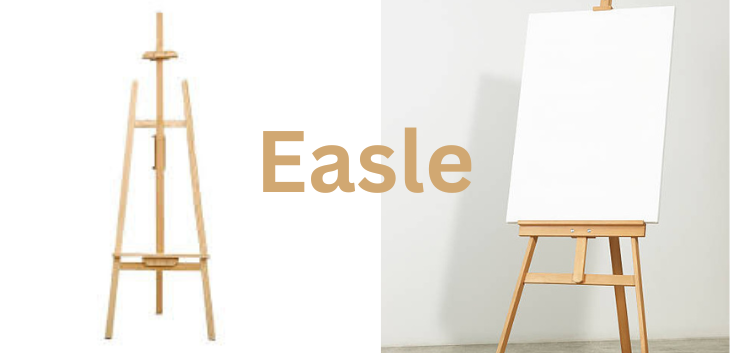Table Of The Content
- Introduction to Easels
- Different Types of Easels
- Tabletop Easels
- Studio Easels
- Plein Air Easels
- Materials Used in Easels
- Factors to Consider When Choosing an Easel
- Size and Weight
- Stability
- Adjustability
- Portability
- Benefits of Using an Easel
- Improved Posture
- Better Perspective
- Enhanced Focus
- Tips for Setting Up and Using an Easel
- Maintenance and Care of Easels
- Popular Brands of Easels
- Conclusion
- FAQs
Easels, the unsung heroes of the art world, are often overlooked but play a crucial role in the creative process of artists across the globe. From holding canvases steady to providing a comfortable working angle, easels are indispensable tools for painters, sketch artists, and anyone involved in visual artistry. In this article, we delve into the world of easels, exploring their types, benefits, and how to choose the perfect one for your artistic endeavors.
1. Introduction to Easle
Easle are supportive structures used by artists to hold their canvas or drawing board upright while they work. They come in various shapes, sizes, and materials to accommodate different artistic styles and preferences.
2. Different Types of Easle
Tabletop Easle
Ideal for artists who work on smaller canvases or limited spaces, tabletop easels are compact and portable. They can be placed on any flat surface, making them suitable for indoor use.
Studio Easle
Designed for larger artworks and professional use, studio easels are sturdy and adjustable, allowing artists to work on canvases of various sizes. They often come with additional features like storage compartments and casters for mobility.
Plein Air Easle
Plein air easels are Specifically crafted for outdoor painting sessions. They are lightweight, collapsible, and easy to transport, making them perfect companions for artists who enjoy capturing landscapes en plein air.
3. Materials Used in Easle
Easels can be made from a variety of materials, including wood, aluminum, and steel. Each material offers different levels of durability, stability, and aesthetics, catering to the diverse needs of artists.
4. Factors to Consider When Choosing an Easle
When selecting an easel, several factors should be taken into account to ensure it meets your requirements:
Size and Weight
Consider the size and weight of the easel, especially if you need to transport it frequently or have limited space in your studio.
Stability
A stable easel is essential for preventing accidents and ensuring a steady working surface, particularly when working with heavy canvases or in windy outdoor conditions.
Adjustability
Look for easels that offer adjustable features such as height and angle to accommodate different canvas sizes and working preferences.
Portability
If you plan to paint on location or attend art classes, opt for a portable easel that is lightweight and easy to set up and dismantle.
5. Benefits of Using an Easel
Using an easel offers several advantages for artists:
Improved Posture
By elevating the canvas to eye level, easels promote better posture and reduce strain on the neck and back during prolonged painting sessions.
Better Perspective
Working on an upright surface helps artists accurately judge proportions and perspective, resulting in more realistic and well-balanced compositions.
Enhanced Focus
Easels create a designated workspace that minimizes distractions and allows artists to fully immerse themselves in their creative process.
6. Tips for Setting Up and Using an Easle
- Ensure the easel is on a stable surface to prevent wobbling or tipping over.
- Adjust the height and angle of the canvas to suit your comfort and painting style.
- Secure the canvas firmly in place to avoid slippage while painting.
7. Maintenance and Care of Easle
Regular maintenance is essential to prolong the lifespan of your easel:
- Keep the easel clean and free from dust and debris.
- Check for loose screws or damaged parts and repair or replace them as needed.
- Store the easel in a dry and well-ventilated area to prevent warping or corrosion.
8. Popular Brands of Easle
There are numerous brands that specialize in manufacturing high-quality easels, including Winsor & Newton, Mabef, and Jack Richeson. Each brand offers a range of models tailored to different budgets and preferences.
9. Conclusion
Easels are indispensable tools for artists, providing stability, comfort, and versatility in their creative pursuits. Whether you’re a seasoned painter or a beginner exploring your artistic talents, investing in a quality easel can greatly enhance your artistic journey.
10. FAQs
1. Can I use an easel for mediums other than painting? Yes, easels can be used for various art mediums, including drawing, sketching, and even displaying finished artworks.
2. Are tabletop easels suitable for professional artists? While tabletop easels are more compact, they can still be used by professional artists, especially for smaller studies or plein air sketches.
3. How do I choose the right size easel for my workspace? Consider the dimensions of your studio or workspace and choose an easel that fits comfortably without overcrowding the area.
4. Can I build my own easel? Yes, there are many DIY easel plans available online for artists who prefer to customize their equipment or save on costs.
5. Are wooden easels better than metal ones? Both wooden and metal easels have their advantages and drawbacks, so the choice ultimately depends on your personal preferences and painting requirements.
